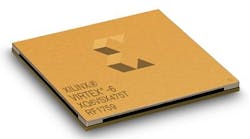Military-grade Virtex-6Q FPGA introduced by Xilinx that operates in temperatures from -55 to 125 C
SAN JOSE, Calif., 29 March 2012. Xilinx Inc. in San Jose, Calif., is introducing the defense-grade Virtex-6Q field-programmable gate array (FPGA) for major military and aerospace applications such as avionics, electronic warfare, missiles and munitions, military communications, and intelligence surveillance reconnaissance (ISR) systems.
Officials of the U.S. National Security Agency (NSA) found the Xilinx Security Monitor (SECMON) IP core in the defense-grade Virtex-6Q provides anti-tamper protection.
These devices together with the SECMON IP core provides a secure embedded computing processor military embedded systems designs in critical anti-tamper applications. The Xilinx secure solution also is appropriate for applications such as commercial avionics.
The programmable anti-tamper solution for the Xilinx Virtex-6Q FPGAs complements anti-tamper system applications overall to protect critical technology as instructed by DOD 5200.39m, Xilinx officials say. Software, IP, documentation, methodologies, working groups, and expertise support is available from Xilinx for anti-tamper implementation.
The Virtex-6Q FPGA also has easy to verify anti-counterfeiting features such as visual identification and confirmation of product authenticity.
Defense-grade Virtex-6Q devices offer mask set control, ruggedized packaging, high-temperature environmental operation and long product life. The FPGAs are fabricated on 40-nanometer dual-oxide process, and are available in versions that operate in temperatures from -40 to 100 degrees Celsius, as well as in the full-military temperature range of -55 to 125 C.
For more information contact Xilinx online at www.xilinx.com.
Follow Military & Aerospace Electronics and Avionics Intelligence news updates on Twitter

